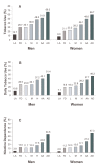An epidemiologic analysis of co-occurring alcohol and tobacco use and disorders: findings from the National Epidemiologic Survey on Alcohol and Related Conditions
- PMID: 17373404
- PMCID: PMC6527037
An epidemiologic analysis of co-occurring alcohol and tobacco use and disorders: findings from the National Epidemiologic Survey on Alcohol and Related Conditions
Abstract
The 2001-2002 National Epidemiologic Survey on Alcohol and Related Conditions (NESARC) sought to determine the prevalence of drinking, smoking, and associated disorders in the general population. This survey, which includes a large representative sample of the adult population of the United States, found that drinking rates were highest among young adults and declined with increasing age. Rates of smoking and co-use of alcohol and tobacco were highest among the youngest respondents and declined thereafter. Similar patterns existed for the presence of alcohol use disorders (AUDs), nicotine dependence, and comorbidity between AUDs and nicotine dependence. Among ethnic/racial groups evaluated, Whites were most likely to drink and Native Americans/Alaskan Natives were most likely to smoke and to have an AUD, nicotine dependence, or comorbid AUD and nicotine dependence. Finally, the rates of tobacco use, daily tobacco use, and nicotine dependence increased with increasing levels of alcohol consumption and the presence of an AUD. These findings have important implications for the development of prevention and intervention approaches.
Conflict of interest statement
The authors declare that they have no competing financial interests.
Figures







References
-
- American Lung Association. Smoking 101. Fact Sheet. New York: American Lung Association; Mar, 2006. Available at: http://www.lungusa.org/site/pp.asp?c=dvLUK9O0E&b=39853.
-
- American Psychiatric Association (APA) Diagnostic and Statistical Manual of Mental Disorders, Fourth Edition (DSM–IV) Washington, DC: APA; 1994.
-
- Centers for Disease Control and Prevention (CDC) The Health Consequences of Smoking: A Report of the Surgeon General. Atlanta, GA: U.S. Department of Health and Human Services, CDC, National Center for Chronic Disease Prevention and Health Promotion, Office on Smoking and Health; 2004.
MeSH terms
LinkOut - more resources
Full Text Sources
Medical
